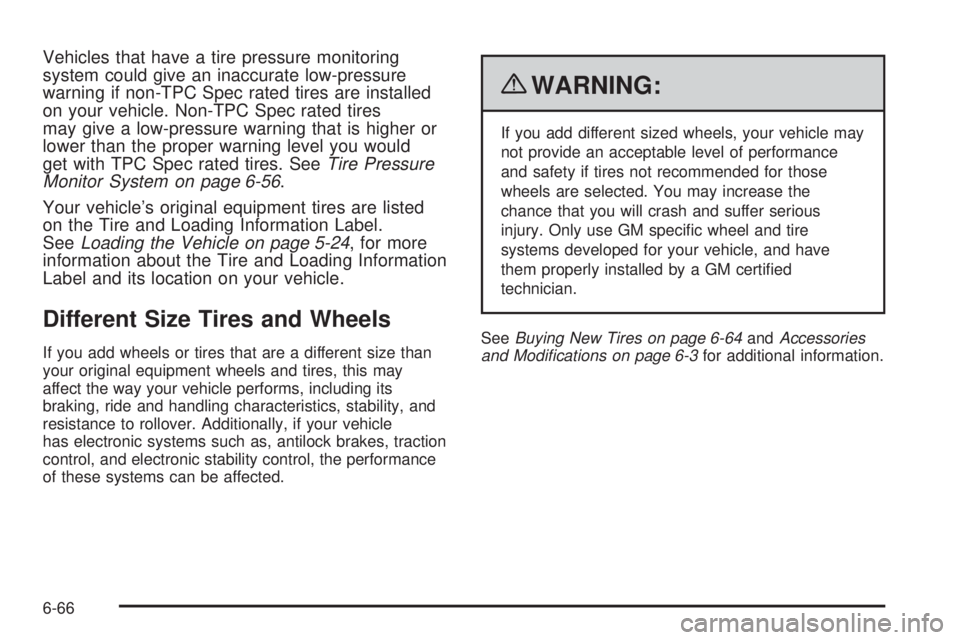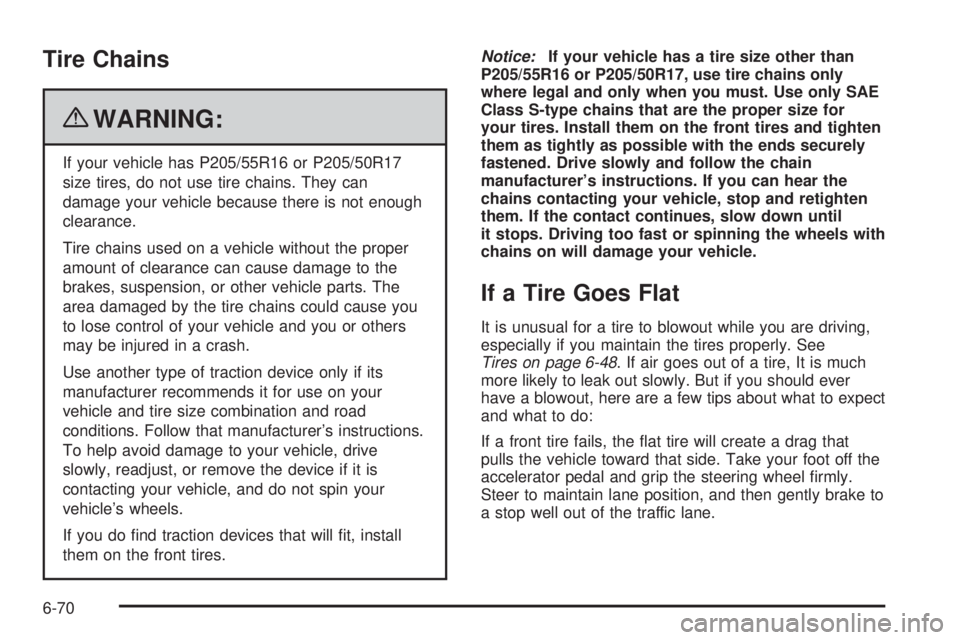brakes PONTIAC G5 2010 Owner's Guide
[x] Cancel search | Manufacturer: PONTIAC, Model Year: 2010, Model line: G5, Model: PONTIAC G5 2010Pages: 422, PDF Size: 2.22 MB
Page 330 of 422

Vehicles that have a tire pressure monitoring
system could give an inaccurate low-pressure
warning if non-TPC Spec rated tires are installed
on your vehicle. Non-TPC Spec rated tires
may give a low-pressure warning that is higher or
lower than the proper warning level you would
get with TPC Spec rated tires. SeeTire Pressure
Monitor System on page 6-56 .
Your vehicle’s original equipment tires are listed
on the Tire and Loading Information Label.
See Loading the Vehicle on page 5-24 , for more
information about the Tire and Loading Information
Label and its location on your vehicle.
Different Size Tires and Wheels
If you add wheels or tires that are a different size than
your original equipment wheels and tires, this may
affect the way your vehicle performs, including its
braking, ride and handling characteristics, stability, and
resistance to rollover. Additionally, if your vehicle
has electronic systems such as, antilock brakes, traction
control, and electronic stability control, the performance
of these systems can be affected.
{WARNING:
If you add different sized wheels, your vehicle may
not provide an acceptable level of performance
and safety if tires not recommended for those
wheels are selected. You may increase the
chance that you will crash and suffer serious
injury. Only use GM specific wheel and tire
systems developed for your vehicle, and have
them properly installed by a GM certified
technician.
See Buying New Tires on page 6-64 andAccessories
and Modi�cations on page 6-3 for additional information.
6-66
Page 334 of 422

Tire Chains
{WARNING:
If your vehicle has P205/55R16 or P205/50R17
size tires, do not use tire chains. They can
damage your vehicle because there is not enough
clearance.
Tire chains used on a vehicle without the proper
amount of clearance can cause damage to the
brakes, suspension, or other vehicle parts. The
area damaged by the tire chains could cause you
to lose control of your vehicle and you or others
may be injured in a crash.
Use another type of traction device only if its
manufacturer recommends it for use on your
vehicle and tire size combination and road
conditions. Follow that manufacturer’s instructions.
To help avoid damage to your vehicle, drive
slowly, readjust, or remove the device if it is
contacting your vehicle, and do not spin your
vehicle’s wheels.
If you do find traction devices that will fit, install
them on the front tires.Notice:
If your vehicle has a tire size other than
P205/55R16 or P205/50R17, use tire chains only
where legal and only when you must. Use only SAE
Class S-type chains that are the proper size for
your tires. Install them on the front tires and tighten
them as tightly as possible with the ends securely
fastened. Drive slowly and follow the chain
manufacturer’s instructions. If you can hear the
chains contacting your vehicle, stop and retighten
them. If the contact continues, slow down until
it stops. Driving too fast or spinning the wheels with
chains on will damage your vehicle.
If a Tire Goes Flat
It is unusual for a tire to blowout while you are driving,
especially if you maintain the tires properly. See
Tires on page 6-48 . If air goes out of a tire, It is much
more likely to leak out slowly. But if you should ever
have a blowout, here are a few tips about what to expect
and what to do:
If a front tire fails, the flat tire will create a drag that
pulls the vehicle toward that side. Take your foot off the
accelerator pedal and grip the steering wheel firmly.
Steer to maintain lane position, and then gently brake to
a stop well out of the traffic lane.
6-70
Page 405 of 422

Reporting Safety Defects to the
Canadian Government
If you live in Canada, and you believe that your
vehicle has a safety defect, notify Transport Canada
immediately, in addition to notifying General Motors of
Canada Limited. Call them at 1-800-333-0510 or write to:Transport Canada
Road Safety Branch
2780 Sheffield Road
Ottawa, Ontario K1B 3V9
Reporting Safety Defects to General
Motors
In addition to notifying NHTSA (or Transport Canada) in
a situation like this, please notify General Motors.
Call 1-800-762-2737, or write:Pontiac Customer Assistance Center
P.O. Box 33172
Detroit, MI 48232-5172
In Canada, call 1-800-263-3777 (English) or
1-800-263-7854 (French), or write: General Motors of Canada Limited
Customer Communication Centre, CA1-163-005
1908 Colonel Sam Drive
Oshawa, Ontario L1H 8P7
Service Publications Ordering
Information
Service Manuals
Service Manuals have the diagnosis and repair
information on engines, transmission, axle suspension,
brakes, electrical, steering, body, etc.
Service Bulletins
Service Bulletins give additional technical service
information needed to knowledgeably service General
Motors cars and trucks. Each bulletin contains
instructions to assist in the diagnosis and service of
your vehicle.
Owner Information
Owner publications are written specifically for owners
and intended to provide basic operational information
about the vehicle. The owner manual includes the
Maintenance Schedule for all models.
In-Portfolio: Includes a Portfolio, Owner Manual, and
Warranty Booklet.
RETAIL SELL PRICE: $35.00 (U.S.) plus processing fee
Without Portfolio: Owner Manual only.
RETAIL SELL PRICE: $25.00 (U.S.) plus processing fee
8-15
Page 410 of 422

Audio System................................................. 4-49
Audio Steering Wheel Controls ......................4-82
Radio Reception .......................................... 4-83
Setting the Clock ......................................... 4-50
Theft-Deterrent Feature ................................4-81
XM™ Satellite Radio Antenna System ............4-84
Audio System(s) ............................................. 4-51
Automatic Door Lock ......................................... 3-9
Automatic Transmission Fluid .......................................................... 6-19
Operation ................................................... 3-24
B
Back-Up Lamps - Ambulance Body
Bulb Replacement ....................................... 6-45
Battery .......................................................... 6-33
Electric Power Management ..........................4-12
Run-Down Protection ................................... 4-13
Belt Routing, Engine ....................................... 7-13
Bluetooth
®..................................................... 4-71
Brake Emergencies ................................................ 5-5
Brakes .......................................................... 6-29
Antilock ....................................................... 5-4
Parking ...................................................... 3-29
System Warning Light .................................. 4-26Braking
........................................................... 5-3
Braking in Emergencies ..................................... 5-5
Break-In, New Vehicle ..................................... 3-19
Bulb Replacement ........................................... 6-47
Back-Up Lamps - Ambulance Body ................6-45
Center High-Mounted Stoplamp (CHMSL) ........6-43
Fog Lamps ................................................. 4-11
Halogen Bulbs ............................................ 6-41
Headlamp Aiming ........................................ 6-38
Headlamps ................................................. 6-41
Headlamps, Front Turn Signal, Sidemarker, and Parking Lamps .................................. 6-42
License Plate Lamps .................................... 6-46
Taillamps and Turn Signal Lamps ..................6-44
Taillamps, Turn Signal, Stoplamps and Back-up Lamps ........................................ 6-44
Buying New Tires ........................................... 6-64
C
California
Perchlorate Materials Requirements ................. 6-4
Warning ....................................................... 6-4
California Fuel .................................................. 6-6
Canadian Owners ............................................... iii
Capacities and Specifications ..........................6-109
2